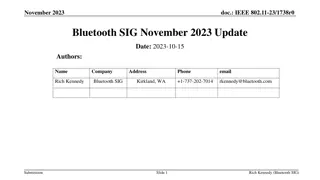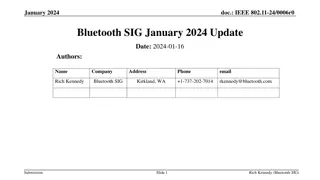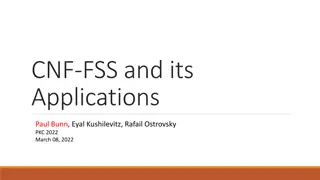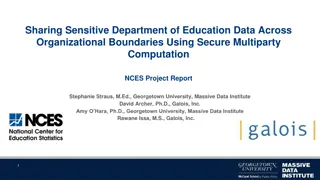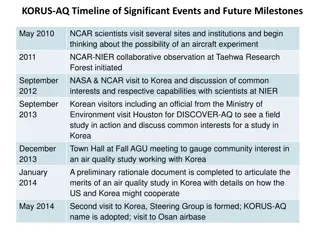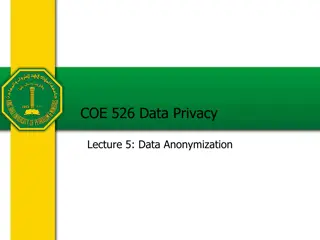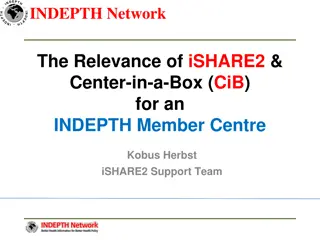
Effective Data Management Plan for KORUS-AQ Airborne Field Study
This data management plan outlines the framework for archiving, managing, and sharing observational data from the KORUS-AQ Airborne Field Study. It details the stages of data submission, from field to final, and emphasizes long-term preservation and distribution. Data flow overview, repositories, submission schedule, and format requirements are also discussed to ensure efficient handling of the data.
Download Presentation

Please find below an Image/Link to download the presentation.
The content on the website is provided AS IS for your information and personal use only. It may not be sold, licensed, or shared on other websites without obtaining consent from the author. If you encounter any issues during the download, it is possible that the publisher has removed the file from their server.
You are allowed to download the files provided on this website for personal or commercial use, subject to the condition that they are used lawfully. All files are the property of their respective owners.
The content on the website is provided AS IS for your information and personal use only. It may not be sold, licensed, or shared on other websites without obtaining consent from the author.
E N D
Presentation Transcript
Data Management Plan for KORUS-AQ Airborne Field Study Dr. Jeong-Hoo Park National Institute of Environmental Research Dr. Gao Chen NASA Langley Research Center
Motivation and Overview Objective: to provide a framework through which the KORUS-AQ observational data are effectively archived, managed, and shared. This document also addresses the plan for long-term preservation and distribution Overview: The KORUS-AQ data submission will be conducted in three stages: field, preliminary, and final. The final data will be open to public and transferred to LaRC ASDC and NIER CAQRD for long-term preservation and distribution
KORUS-AQ Data Flow Overview KORUS-AQ Data Repositories Field Data Preliminary Data Final Data calibration/ characterization Post-field data processing Data QA/QC Synchronization Collecting data In-field data processing Initial data QA/QC Final QA/QC, including integrated processing Synchronization Transfer to NIER CAQRD and LaRC ASDC (DAAC) Field Deployment Phase Post Deployment Phase Public Phase
KORUS-AQ Data Repositories and Data Holdings NASA Data Repository: www-air.larc.nasa.gov NASA DC-8 and King Air Ozonesonde, Ozone LIDAR and Pandora Other relevant model, trajectory and satellite data NEIR Data Repository: www.nier.go.kr KMA King Air and Hanseo King Air Kisang I and Onnuri Ground sites Both data repositories will use the same username and password for access control Weblink will be provided for AERONET data website
KORUS-AQ Data Submission Schedule Mission Phase Data Repository Submission Deadline Access Control Data Type 24 hour after each flight or cal. Day NASA Field Deployment Science team and Partners Field Data NEIR NASA Post- Deployment Preliminary Data Science team and Partners January 15, 2017 NEIR June 15, 2017 NASA Public Final Data Public June 15, 2018 NEIR Field data submission deadline may vary depending on field operation constraints Preliminary and field data will be expunged after their operation periods, respectively The final data due date difference is driven by data policies at NASA and NEIR
KORUS-AQ Data Format Requirements The data from KORUS-AQ field study will conform to ICARTT or HDF format All in-situ measurements are required to report data in ICARTT format. Detailed format description can be found at: http://www- air.larc.nasa.gov/missions/etc/IcarttDataFormat.htm. All incoming data files from in-situ measurements will be scanned to ensure compliance to the ICARTT format requirements Assistance will be made available to the science team to trouble- shoot issues in generating ICARTT files. The remote sensing measurement instruments may report data in either HDF or ICARTT format
KORUS-AQ Data File Naming Convention DataID_LocationID_YYYYMMDD_R#_Description.extension DataID: a short description of measured parameter/species, instrument, or model LocationID: an identifier of measurement platform: e.g. DC8, will be provided on the website in a drop-down box YYYYMMDD: UTC date when the flight take off or the beginning of the measurement for ground sites R#: Revision number. The revision number will be RA, RB, RC, for field data and R0, R1, R2, for the preliminary and final data. Note: archived files cannot be overwritten Description: optional additional description of the file if necessary Extension: ict for ICARTT files, h4 for HDF 4 files, and h5 for HDF 5 files, etc. Examples: the filename for DC-8 diode laser spectrometer H2O measurement made on May 1, 2016 flight may be: KORUSAQ-DLH-H2O_DC8_20160501_RA.ICT (for field data) KORUSAQ-DLH-H2O_DC8_20160501_R0.ICT (for preliminary or final data)
KORUS-AQ Data Reporting Requirements KORUS-AQ Metadata Requirements: The KORUS-AQ data files should be self-describing with sufficient information on: variable definition, unit, data reporting information, measurement description, measurement uncertainty and detection limits The metadata requirements for ICARTT and HDF files are uniform. Details will be provided in the Data Management Plan. DataID Registration: PI will need to register his/her dataID before file submission. DataID is used to organize file on the data repository and is a part of the KORUS-AQ file naming convention. DataID is a typically short description of measured parameter/species, instrument, or model (e.g., KORUSAQ-O3). The website will be open for DataID registration in late March, 2016 and detailed instruction will be distributed.
KORUS-AQ Science Data Policy All participants are requested to accept the following responsibilities: Submit data in ICARTT or HDF format no later than the specified deadlines If unexpected events lead to any delay in data submission, the PI is required to notify the project leadership as soon as issues are known Final data should be submitted to the archive prior to any presentation at scientific conferences (e.g. AGU, AMS) or manuscript preparation, unless explicit authorization is obtained from the program managers All aircraft measurements from a common platform should be synchronized to science team pre-agreed time standard, e.g. DLH for DC-8 Consult with PIs when using their data in conference/data workshop presentations and/or manuscript Invite PIs of any data used to be co-authors (particularly during post- deployment research phase) PIs should be available to answer questions about their data
Data Managers The KORUS-AQ Data Manager will monitor the data submission status in accordance with the data submission timeline. The data manager will also coordinate the efforts to support implementation of ICARTT format Gao Chen, NASA Langley Research Center, gao.chen@nasa.gov, 757-864-2290 Jeong-Hoo Park National Institute of Environmental Research jeonghoo@korea.kr, +82-32-560-7717
Additional Requirements for Enhancing KORUS-AQ Data Quality Data Synchronization standards: DC8: DLH King Airs? All aerosol extensive measurements are reported in STP (i.e., 273.15K and 1013 mb), including optical measurements 1 sec files start and stop at the common take- off and landing time 1 sec. cloud marker/flag?
Additional Requirements for Enhancing KORUS-AQ Data Quality (Cont.) Use fixed variable name(s) for Time Stamps, i.e., Time_Start, Time_Stop, and Time_Mid Use the same number of variables and variable names throughout mission for the files with the same same dataID While no standard short variable name recommendations, please consider add a common variable name after the short name, unit . These are recommended ICARTT format changes under discussion





